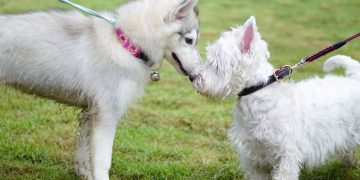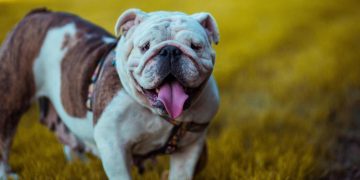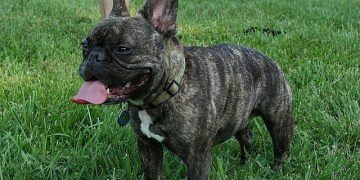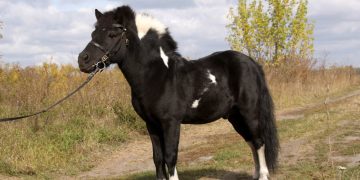When a dog is labeled as “aggressive,” people typically think this means the dog is a bad animal. But that’s far from the case. He’s not a bad dog—he’s a dog that has not been heard, a dog that needs space, or a dog that experienced some trauma that’s changed how he responds to real or perceived threats.
There are many underlying reasons why a dog can escalate to aggressive behavior such as growling, barking, lunging, baring teeth, snapping, or biting—one of which is fear. Fear is a negative emotional response to a trigger. A trigger can be a person, another dog, an object, or a situation that ignites an emotional response, and it can be either a true or perceived threat.
What Is Fear Aggression in Dogs?
Fear aggression happens when a dog wants to increase distance between himself and a trigger (commonly another animal or a human). He’s saying that he doesn’t want to engage and that the other party should keep their distance.
Essentially, fearful dogs want to create distance. When their message is ignored and distance is not created, they feel trapped and might escalate their behavior. Aggressive dogs with fear as the underlying motivation may exhibit defensive or offensive behavior, depending on previous negative experiences, level of socialization, and genetic predisposition.
Signs of Fear Aggression in Dogs
Dog body language associated with fear includes:
Ears turned to the side or pinned to the back of the head
Lip licking
Panting
Pacing
Body tremors
Direct eye contact or whale eyes (you can see the whites)
Bristling hairs (piloerection)
Avoidance behavior
Vocalizations such as whining, barking, or growling
When his initial signs of fear are ignored, the dog may exhibit more intense and difficult-to-ignore behaviors, such as jumping up, lunging, or biting. After repeated exposure to threats or situations where the pet feels overwhelmed and fearful, his behavior can easily escalate to aggression without much warning.
When a dog is defensive, he typically won’t become aggressive unless directly approached or touched. But when a dog has prior negative experiences where he couldn’t escape the threat, he may exhibit offensive fear aggression, moving toward the trigger and exhibiting threatening and aggressive behavior.
Causes of Fear Aggression in Dogs
There are many reasons why dogs develop fear aggression. The dog may have received inadequate socialization as a puppy, may have been exposed to early traumatic experiences, may have experienced punishment (such as having his leash tugged while wearing a choke or prong collar), or may have a genetic predisposition that makes him more likely to respond fearfully in certain situations.
Common stimuli that can trigger a fear-based aggressive reaction in dogs include:
Strangers reaching toward their head
Another dog or a person making direct eye contact
Having their nails trimmed
Having their ears plucked
Having their ears cleaned
Being bathed
Being shaved
Being approached or petted when they are lying down
Being hugged
Getting a needle injection
Being restrained by a stranger
Having their fur grabbed
Being touched in a sensitive area, such as their tail, paws, or belly
Remember: Fear can be caused by a real or perceived threat. And fear is subjective: One dog may not be fearful of certain items or situations, while another dog may have a different response when exposed to the same thing.
When a dog has experienced a traumatic or negative event, such as being hit with a rolled-up newspaper, he can easily escalate to being aggressive when confronted again with violent behavior. In the future, the dog may also escalate to aggressive behavior at the sight of the newspaper—or any object his human holds.
How To Deal With Fear Aggression in Dogs
1. Redirect the Dog
The best thing a pet parent can do when their dog has escalated aggressive behavior is to remove the dog from that situation or remove the trigger that the dog found threatening.
If you’re the reason the dog is directing the aggressive behavior, step out of sight.
If the dog is reacting to a different trigger, distract and redirect your dog’s focus and ask him to perform alternative behaviors.
Performing other behaviors can help calm the dog, especially if he associates those behavioral cues with a happy emotional response. Asking your dog to perform “look,” “touch,” “find it,” or any other cues the dog enjoys—and then offering him treats and praise for those behaviors—can help him recover after being exposed to a threatening trigger.
For example, if you have a dog that barks at other dogs, as soon as you see another dog approaching, immediately ask your dog to touch your hand for a food reward. Then follow up with a “find it” cue to search for treats until the other dog has gone out of sight.
2. Never Use Punishment
You cannot correct fear or aggression with punitive measures, such as scolding or applying physical correction through a choke, pinch, or shock collar. The use of punitive techniques can inhibit the dog’s behavior in your presence and even teach him to not exhibit warning signals—where the dog then bites without warning in the future.
Using punitive techniques can increase fear and anxiety. Punitive techniques and tools have also been associated with an increased risk of aggressive behavior directed toward you and other family members.
The kinder, gentler way to work with your dog is with positive-reinforcement training methods. Dogs trained using positive reinforcement have been found to be more optimistic and resilient. The use of positive-reinforcement training can help build the dog’s confidence and strengthen the human-animal bond.
3. Try Pheromones
Supplements such as pheromone sprays can decrease anxiety to some extent in certain dogs, but these will not resolve aggressive behavior. Behavioral medications can also reduce anxiety. But when the dog continues to encounter the trigger or continues to feel threatened or feel like he cannot escape, aggressive behavior may still occur.
To be effective, behavioral medication must be used in conjunction with a behavior modification program. Discuss with your veterinarian the best treatment plan for your dog.
4. Seek Help From a Professional
Pet parents should seek professional assistance, such as from a veterinary behaviorist, certified applied animal behaviorist, or certified trainer, as soon as their dog exhibits signs of fearful and/or aggressive behavior.
These professionals will recommend how to manage the dog around his trigger. They’ll also recommend training and behavior modification exercises to help reduce the dog’s fear and increase his confidence and tolerance. The veterinary behaviorist can determine a diagnosis, give a prognosis, and discuss if behavioral medications are an option for your pet.
How To Prevent Fear Aggression in Dogs
To prevent fearful and/or aggressive behavior from forming in the first place, pet parents should:
Socialize your puppy by taking him to socialization classes when he’s eight to 16 weeks old.
Closely supervise your dog’s interactions with people, children, and other dogs and animals, ensuring your pet doesn’t appear fearful or overwhelmed.
Carry high-value treats to help your dog form positive associations with stimuli he initially appears uncomfortable with.
Never use punitive techniques and avoid teasing or threatening behaviors that trigger an aggressive reaction (like pulling on a dog’s tail).
Be gentle, kind, patient, and consistent with your dog and reinforce the appropriate behaviors you want to see your pup exhibit by offering verbal praise and rewards.

























